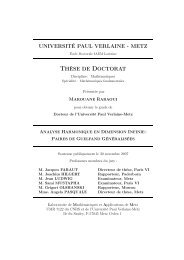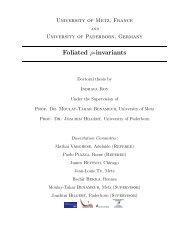Create successful ePaper yourself
Turn your PDF publications into a flip-book with our unique Google optimized e-Paper software.
34 Dual topology of the motion groups SO(n) ⋉ R n<br />
Hence, we obtain<br />
〈Ad ∗ ((A, a))(U, u), (B, b)〉 = 〈(AUA t + ((Au)a t − a(Au) t ), Au), (B, b)〉,(2.2)<br />
i.e.,<br />
Ad ∗ ((A, a))(U, u) = (AUA t + [(Au)a t − a(Au) t ], Au). (2.3)<br />
Therefore, for u �= 0, the co-adjoint orbit OU,u is given by<br />
OU,u = Ad ∗ (Mn)(U, u) = {(AUA t + [(Au)a t − a(Au) t ], Au), A ∈ SO(n), a ∈ R n (2.4) }<br />
= {(AUA t , Au), A ∈ SO(n)} + (AWuA t , 0),<br />
where Wu = {ua t − au t , a ∈ R n } is a subspace of dimension n − 1 of so(n).<br />
Remark 2.2.1. We <strong>de</strong>duce from this expression that the orbit OU,u is closed<br />
and that the Mn-invariant measure dβU,u of the orbit OU,u can be written as<br />
�<br />
� �<br />
ϕ(q)dβU,u(q) =<br />
OU,u<br />
SO(n)<br />
Wu<br />
2.2.1 The dual space of SO(n).<br />
ϕ((AUA t , Au)+(ABA t , 0))dBdA, ϕ ∈ Cc(OU,u).<br />
(2.5)<br />
We need a precise <strong>de</strong>scription of the irreducible representations of SO(n) (see<br />
[Knapp] for <strong>de</strong>tails).<br />
A Cartan subalgebra of so(n) can be taken to consist of the two-by-two<br />
diagonal blocks<br />
� 0 θj<br />
−θj 0<br />
�<br />
, j = 1, · · · , [n/2] starting from the upper left<br />
(here [m], m ∈ R, <strong>de</strong>notes the largest integer smaller than m). For an integer<br />
j ∈ [1, [n/2]] <strong>de</strong>note by ej the associated evaluation functional on the<br />
complexification of the Cartan subalgebra. When n is even, say n = 2d, the<br />
roots are the functionals ±ei ± ej with 1 ≤ i < j ≤ d. When n is odd, say<br />
n = 2d + 1, the roots are the functionals ±ei ± ej with 1 ≤ i < j ≤ d and<br />
also the ±ej with 1 ≤ j ≤ d. We take the positive roots to be the ei ± ej<br />
with i < j and, when n is odd, the ej.<br />
The dominant integral forms λ for SO(n) are given by expressions<br />
λ1e1 + ... + λ<strong>de</strong>d ←→ λ = (λ1, ..., λd) (2.6)<br />
such that λ1 ≥ ... ≥ λd−1 ≥ |λd| when n = 2d is even, and λ1 ≥ ... ≥ λd ≥ 0<br />
when n = 2d + 1 is odd, with all the λj’s un<strong>de</strong>rstood to be integers. Hence<br />
the dual space of SO(n) is <strong>de</strong>termined by the representations τλ, given by its





